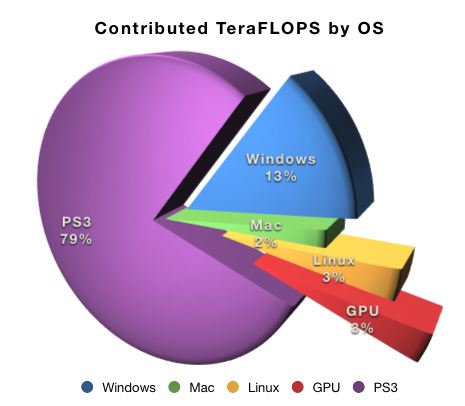PS3 gamers are real world heroes

Quick, are gamers socially impaired, violence prone losers or technically hip, socially conscious good guys? The numbers don't lie: Sony Playstation3 participation is 30x that of Windows machines in Stanford's disease fighting Folding@home project. And PS3s provide 80% of the TFLOPS this project uses.
Virtual disease vs. real disease In the popular PS3 game Resistance: Fall of Man the alien Chimera expand their number by infecting humans with a coma-inducing virus. In the real world, hundreds of thousands of PS3 gamers are using their machines to fight real brain-destroying Alzheimers and Creutzfeldt-Jakob disease, as well as cystic fibrosis and other diseases now thought to have protein-folding components.
The science Protein folding is vital to understanding cell biology. DNA specifies long sequences of amino acids that form proteins. These proteins are used as enzymes to drive cell chemistry, antibodies in the immune system and as a major structural component in bones, muscles and skin. Once a protein sequence is assembled, the protein self-assembles itself by folding into its final shape.
Proteins fold quickly, some as fast as one-millionth of a second. Simulating the folding is much slower. The F@H site notes:
In fact, it takes about a day to simulate a nanosecond (1/1,000,000,000 of a second). Unfortunately, proteins fold on the tens of microsecond timescale (10,000 nanoseconds). Thus, it would take 10,000 CPU days to simulate folding -- i.e. it would take 30 CPU years!
A non-trivial problem.
Got a PS3? It is easy to join F@H.
If you have PS3 system version 1.6 or later, you will see a Folding@Home icon in the Network column of the XMB (PS3 menu). Just click on the icon and that's it. If you don't have 1.6 or later, please perform a system upgrade.
The TFLOPS numbers are based on the software, not theoretical hardware numbers. The Stanford team has hand-tuned the codes for each platform.
Windows & Mac users: socially impaired losers? Or uncaring brutes? Why choose, it could be both.
A word about the numbers. The Stanford team updates their statistics continually, so when you look you'll see different numbers. I got these on Sunday:
I was interested in the participation by platform, so I hunted around the web for some numbers, and found the Computer Industry Almanac Inc. estimate of 1 billion in 2007. Then I looked at Net Applications breakdown of operating system marketshare.
The market share numbers for Linux and Mac are dodgy. The Mac numbers are about double what I'd imagined. The Windows numbers aren't perfect either: lots of Windows machines are used for POS terminals and such so they shouldn't be counted either. But the magnitudes are about right.
The Storage Bits take It is traditional for the older generation to complain about the younger, but in this case baby boomers should be thanking gamers for their support of this important research.
Learn more about PS3s as supercomputers in Build an 8 PS3 supercomputer.
